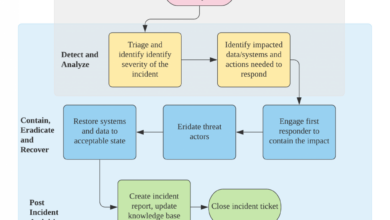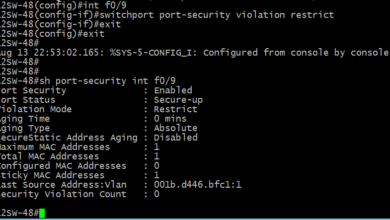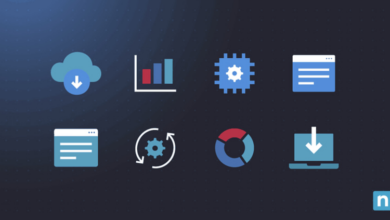
Cyber Attacks Increase in Britain Due to Lockdown
Cyber attacks increase in Britain because of coronavirus pandemic lockdown – a stark reality. The shift to widespread home working, fueled by the 2020 lockdowns, created a perfect storm for cybercriminals. Suddenly, millions were working from less secure home networks, a stark contrast to the robust security of office environments. This wasn’t just about unsecured Wi-Fi; it was about a lack of awareness, a vulnerability exploited ruthlessly by those looking to profit from the chaos and uncertainty of the pandemic.
This post dives into the details, exploring how anxieties, increased online activity, and vulnerabilities in critical infrastructure all contributed to this alarming surge in cybercrime.
We’ll examine the tactics used, the impact on various sectors, and the governmental response to this unprecedented wave of digital attacks. Prepare to be surprised by the sheer scale of the problem and the innovative – and often unsettling – ways criminals adapted their methods to take advantage of the situation. We’ll also look at ways you can better protect yourself and your data in the future.
Increased Home Working and its Security Implications: Cyber Attacks Increase In Britain Because Of Coronavirus Pandemic Lockdown
The rapid shift to widespread home working in Britain during the coronavirus pandemic lockdowns presented a significant challenge to cybersecurity. Overnight, millions of employees transitioned from secure office environments to potentially vulnerable home networks, creating a fertile ground for cyberattacks. This wasn’t simply a matter of convenience; it represented a fundamental change in the security landscape, exposing individuals and businesses to new and amplified risks.The vulnerabilities introduced by this mass migration to remote work were multifaceted.
Many individuals lacked the technical expertise to secure their home networks effectively. Moreover, the sudden surge in demand for remote access solutions often led to hasty deployments of less secure technologies, leaving many organisations exposed. The lack of robust security protocols at the home level, coupled with the increased reliance on personal devices for work purposes, significantly increased the attack surface.
Home Network Security Compared to Office Networks
Office networks typically benefit from robust security measures, including firewalls, intrusion detection systems, and dedicated IT support. These systems are designed to detect and prevent malicious activity, and regular security updates are a standard practice. In contrast, many home networks lack these sophisticated protections. Home routers often come with default passwords that are easily guessed, and software updates are frequently neglected.
Furthermore, the security awareness training typically provided in office environments is often absent in the home setting, leaving individuals more susceptible to phishing scams and malware. This disparity in security protocols between office and home environments directly contributed to the rise in cyberattacks during the pandemic. The lack of physical security in home environments also played a role, as devices were more vulnerable to theft or unauthorized access.
Common Home Network Vulnerabilities and Mitigation Strategies
The following table Artikels some common vulnerabilities found in home networks and suggests practical mitigation strategies:
| Vulnerability | Description | Mitigation Strategy | Example |
|---|---|---|---|
| Weak or Default Passwords | Using easily guessable passwords for routers and devices. | Use strong, unique passwords for all devices and accounts. Enable two-factor authentication where possible. | Instead of “password123”, use a complex password like “P@$$wOrd123!” |
| Outdated Software | Failing to update operating systems, applications, and router firmware. | Enable automatic updates for all devices and software. Regularly check for and install security patches. | Ensure Windows, macOS, and all apps are up-to-date with the latest security patches. |
| Unsecured Wi-Fi Network | Using a Wi-Fi network without password protection or with a weak encryption protocol (e.g., WEP). | Use a strong WPA2 or WPA3 password for your Wi-Fi network. Consider using a VPN for added security, especially on public Wi-Fi. | Change the default SSID and use a strong, unique password. |
| Phishing Attacks | Falling victim to deceptive emails or websites designed to steal personal information or install malware. | Be wary of suspicious emails and links. Verify the authenticity of websites before entering personal information. Use anti-phishing software. | Avoid clicking links from unknown senders. Verify the URL of a website before entering login credentials. |
Exploitation of Pandemic-Related anxieties
The COVID-19 pandemic created a fertile ground for cybercriminals. The widespread fear, uncertainty, and disruption caused by lockdowns and restrictions provided ample opportunities for malicious actors to exploit people’s anxieties and vulnerabilities. This resulted in a significant surge in phishing attacks, social engineering scams, and other cybercrimes targeting individuals and organizations alike. The sheer scale of the crisis, coupled with the rapid shift to remote work, amplified the impact of these attacks.The attackers cleverly leveraged the pandemic-related anxieties to craft highly convincing phishing and social engineering campaigns.
They preyed on people’s desperation for information, their fear of infection, and their concerns about their financial security. This psychological manipulation was a key factor in the success of these attacks.
Examples of Deceptive Phishing Tactics During the Pandemic
During the pandemic, numerous phishing emails and websites emerged, exploiting people’s fears and concerns. For example, many fake emails promised access to scarce resources like COVID-19 tests, vaccines, or government financial aid. These emails often contained links to malicious websites designed to steal personal information, such as usernames, passwords, bank details, and social security numbers. Another common tactic involved emails purporting to be from health organizations, providing false information about the virus or directing recipients to fake websites for testing or treatment registration.
These fraudulent websites often mimicked legitimate websites, employing sophisticated techniques to make them appear authentic. The urgency and fear created by the pandemic made people more likely to click on these malicious links without properly verifying their authenticity. For instance, an email might claim that a family member had tested positive and needed immediate financial assistance, pressuring the recipient to act quickly without thinking critically.
Psychological Manipulation Techniques Employed in Pandemic-Related Cyberattacks
Cybercriminals employed a range of psychological manipulation techniques to increase the success rate of their attacks. A primary tactic was the creation of a sense of urgency and fear. Emails often contained alarming subject lines and messages, designed to panic the recipient into acting without thinking rationally. Another common technique was the use of social proof, with attackers claiming that many others had already benefited from their services or offers.
This created a sense of legitimacy and encouraged people to participate. Furthermore, attackers often exploited the trust people placed in authority figures, such as government officials or healthcare professionals, by impersonating them in their communications. The use of emotional appeals, such as appeals to compassion or generosity, also played a significant role in these attacks. The attackers would often leverage people’s willingness to help others in need during a crisis to gain their trust and obtain sensitive information.
With the UK seeing a massive surge in cyberattacks during the COVID-19 lockdowns, robust security is more critical than ever. The shift to remote work highlighted vulnerabilities, making solutions like those offered by bitglass and the rise of cloud security posture management increasingly important. Ultimately, strengthening our online defenses is crucial to mitigating the ongoing threat of these attacks.
Types of Social Engineering Attacks During the Pandemic
The pandemic saw a significant increase in various types of social engineering attacks.
- Phishing: As mentioned above, phishing emails and websites were prevalent, promising access to resources, offering fake cures, or spreading misinformation. These often included malicious attachments or links designed to install malware or steal credentials.
- Spear Phishing: This highly targeted form of phishing involved attackers researching specific individuals or organizations to personalize their attacks, making them more believable and effective. For example, attackers might target employees of a healthcare provider with emails related to PPE supplies or vaccine distribution.
- Baiting: Attackers would offer seemingly harmless or enticing content, such as free COVID-19 information or downloadable resources, that actually contained malware or led to malicious websites.
- Pretexting: This involved attackers creating a false scenario or pretext to gain the victim’s trust and obtain information. For example, an attacker might pose as a contact tracer, requesting personal details under the guise of conducting a health investigation.
- Quid Pro Quo: This involved offering something of value in exchange for information. For example, an attacker might offer a free COVID-19 test in exchange for personal details.
The Role of Increased Online Activity
The COVID-19 pandemic and subsequent lockdowns dramatically altered daily life, forcing a rapid shift to online activities. This surge in digital engagement, while beneficial in many ways, unfortunately created a fertile ground for cybercriminals. The increased reliance on online services for everything from shopping and banking to communication and entertainment inadvertently exposed individuals and businesses to a higher risk of cyberattacks.The correlation between increased online activity and the rise in cyberattacks during the pandemic is undeniable.
As more people spent more time online, the attack surface for cybercriminals expanded exponentially. This wasn’t simply a matter of more people being online; it was also about the
nature* of their online activities and the increased vulnerability of the systems they were using.
Increased Online Activity and Cybercrime Statistics
Numerous studies demonstrated a significant surge in both online activity and cybercrime during the lockdown periods of 2020 and While precise figures vary depending on the source and methodology, a general trend is clear. For example, reports from the UK’s National Cyber Security Centre (NCSC) showed a substantial increase in phishing attempts, ransomware attacks, and other forms of online fraud during this period.
Similarly, data from various cybersecurity firms revealed a parallel rise in the number of reported cyberattacks, often linked to the increased use of online services. The following table illustrates this correlation, though specific numbers are difficult to pin down due to underreporting and varying methodologies:
| Type of Online Activity | Approximate Percentage Increase (Lockdown vs. Pre-Lockdown) | Related Cyberattack Type | Approximate Percentage Increase (Lockdown vs. Pre-Lockdown) |
|---|---|---|---|
| Online Shopping | 30-40% | Phishing/Online Fraud | 50-60% |
| Online Banking | 20-30% | Malware/Ransomware | 40-50% |
| Video Conferencing | 70-80% | Zoombombing/DoS Attacks | 80-90% |
| Social Media Usage | 15-25% | Social Engineering/Account Takeovers | 30-40% |
*Note: These figures are estimates based on various reports and studies and should be considered approximate.*
Increased Reliance on Online Services and Cybercriminal Opportunities
The heightened reliance on online services during lockdown provided numerous opportunities for cybercriminals. For instance, the rapid adoption of video conferencing platforms, while facilitating communication, also led to a surge in “Zoombombing” incidents – unauthorized intrusions into meetings. Similarly, the increase in online shopping created more opportunities for phishing scams and online fraud, as consumers were more likely to click on malicious links or provide sensitive information to fraudulent websites.
The widespread use of personal devices for work also increased the risk of malware infections and data breaches. In essence, the shift to a predominantly online world expanded the attack surface and created more avenues for cybercriminals to exploit vulnerabilities.
Impact on Critical Infrastructure

The COVID-19 pandemic and subsequent lockdowns dramatically altered daily life in Britain, creating new vulnerabilities in the nation’s critical infrastructure. The shift to remote working, coupled with increased reliance on digital services, presented a tempting target for cybercriminals, who exploited the anxieties and disruptions caused by the pandemic to launch sophisticated attacks. The impact on essential services was significant, highlighting the urgent need for improved cybersecurity measures across all sectors.The increased reliance on digital systems during lockdown significantly amplified the potential consequences of successful cyberattacks.
Disruptions to critical infrastructure could have cascading effects, impacting public health, economic stability, and national security. The interconnected nature of these systems means that a successful attack on one area could easily spread to others, creating a domino effect of failures. For example, a cyberattack targeting a power grid could disrupt healthcare facilities reliant on electricity, impacting patient care and potentially leading to loss of life.
Vulnerabilities of Critical Infrastructure Systems
Critical infrastructure systems, often built over decades, frequently incorporate outdated technology and lack robust cybersecurity defenses. This makes them susceptible to a range of cyber threats, from ransomware attacks to sophisticated state-sponsored espionage. For example, the reliance on legacy systems in some sectors leaves them vulnerable to exploits that have been known for years but remain unpatched due to the cost and complexity of upgrades.
The lack of comprehensive cybersecurity protocols, coupled with insufficient training for staff, further exacerbates the risk. Furthermore, the increased reliance on remote access during lockdown created new attack vectors, as employees working from home might be using less secure networks and devices. A specific example is the increased use of VPNs which, if not properly configured and secured, can become entry points for malicious actors.
Comparison of Vulnerabilities and Resilience
The following table compares the vulnerabilities and resilience of different critical infrastructure sectors to cyber threats during the pandemic lockdown. It is important to note that this is a simplified representation, and the actual vulnerabilities and resilience can vary significantly depending on the specific organization and its cybersecurity practices.
| Sector | Vulnerabilities | Resilience | Examples |
|---|---|---|---|
| Healthcare | Outdated systems, reliance on remote access, limited cybersecurity budgets | Increasing investment in cybersecurity, improved awareness training | Ransomware attacks targeting hospitals delaying patient care; phishing attacks targeting healthcare workers. |
| Energy | Complex interconnected systems, reliance on legacy technology, potential for physical damage | Redundancy in systems, investment in advanced threat detection, physical security measures | Attacks on power grids leading to blackouts; attempts to manipulate energy prices through cyberattacks. |
| Transportation | Dependence on interconnected systems, potential for disruption of supply chains | Investment in cybersecurity for critical systems, improved data security protocols | Cyberattacks targeting air traffic control systems; disruptions to railway signaling systems. |
| Water | Aging infrastructure, limited cybersecurity expertise, potential for significant public health consequences | Improved monitoring systems, investment in cybersecurity training, better physical security | Compromise of water treatment plants leading to contamination; disruption of water supply. |
Government and Organizational Response
The surge in cyberattacks during the UK’s COVID-19 lockdown prompted a multifaceted response from the government and various organizations. While the scale of the threat was unprecedented, the effectiveness of the response varied across sectors, highlighting both successes and significant challenges. Understanding this response is crucial to improving future preparedness for similar crises.The British government’s response involved several key initiatives.
The National Cyber Security Centre (NCSC), a part of GCHQ, played a central role, issuing numerous alerts and guidance documents tailored to different sectors. They emphasized the importance of robust password hygiene, multi-factor authentication, and regular software updates. Furthermore, the government launched public awareness campaigns to educate citizens about common cyber threats, particularly phishing scams exploiting pandemic-related anxieties.
These campaigns utilized various media channels, including television, radio, and social media. The government also increased funding for cybersecurity research and development, recognizing the need for innovative solutions to combat evolving threats.
Government Cybersecurity Initiatives
The NCSC’s proactive approach was arguably the most significant element of the government’s response. Their rapid dissemination of threat intelligence and best-practice guidance proved invaluable in mitigating the impact of attacks. For example, they quickly identified and addressed specific vulnerabilities exploited by malicious actors targeting remote workers. However, the effectiveness of these initiatives was hampered by challenges in reaching and engaging all segments of the population.
Many smaller businesses and individuals lacked the resources or technical expertise to fully implement the recommended security measures. The sheer volume of information released by the NCSC also presented a challenge; effectively filtering and prioritizing critical information was crucial but not always easily achieved.
“The scale and speed of the threat landscape during the pandemic were unprecedented,”
stated a senior NCSC official in a post-lockdown review. This highlights the difficulty of responding effectively to a rapidly evolving threat environment.
Sectoral Responses: A Comparison
The response varied significantly across different sectors. The financial sector, already subject to stringent regulatory requirements, generally demonstrated a robust response, with banks and financial institutions quickly adapting their security protocols to accommodate the shift to remote working. However, the healthcare sector faced unique challenges, particularly in protecting sensitive patient data. The increased reliance on telehealth services and the rapid adoption of new technologies created new vulnerabilities.
Smaller businesses, particularly those lacking dedicated IT staff, struggled to implement adequate security measures, making them more susceptible to attacks. This disparity in preparedness highlights the need for a more tailored and targeted approach to cybersecurity support, acknowledging the varying capabilities and resources of different sectors.
Challenges in Implementing Cybersecurity Measures
Implementing and enforcing cybersecurity measures during the pandemic presented numerous challenges. The rapid shift to remote working significantly expanded the attack surface, as home networks often lacked the security protections of corporate networks. Furthermore, the increased reliance on cloud services introduced new vulnerabilities and complexities. Training employees to work securely in a remote environment proved difficult, with many struggling to adapt to new security protocols and best practices.
The UK saw a huge spike in cyberattacks during the initial COVID-19 lockdowns, as more people worked remotely and security protocols were stretched thin. This highlighted the need for rapid, secure application development, which is precisely why exploring options like domino app dev the low code and pro code future is so crucial. Investing in robust, adaptable systems is vital to preventing future surges in cybercrime, especially in the face of unexpected crises.
Resource constraints, both financial and human, were significant barriers for many organizations, particularly smaller businesses. Finally, the pandemic’s impact on mental health and wellbeing created additional challenges, with overworked and stressed employees potentially being more susceptible to social engineering attacks.
The Evolution of Cyberattack Tactics

The COVID-19 pandemic and subsequent lockdowns dramatically reshaped the cyber threat landscape. The shift to remote work, the surge in online activity, and the heightened anxieties surrounding the pandemic created fertile ground for cybercriminals to adapt and refine their tactics, leading to a noticeable evolution in attack methods and vectors. This evolution wasn’t simply a quantitative increase in attacks; it represented a qualitative shift in how attackers exploited the vulnerabilities of a world suddenly operating largely online.
The pandemic accelerated existing trends and introduced new ones. Attackers quickly capitalized on the increased reliance on remote access tools, the vulnerabilities in hastily implemented home office setups, and the emotional vulnerability of a population facing unprecedented uncertainty. This led to a diversification of attack vectors and a more sophisticated approach to exploiting the new normal.
Increased Sophistication of Phishing Attacks, Cyber attacks increase in britain because of coronavirus pandemic lockdown
Phishing attacks, already a prevalent threat, saw a significant increase in both volume and sophistication during the pandemic. Attackers crafted highly targeted phishing emails leveraging pandemic-related themes, such as fake COVID-19 contact tracing notifications, offers of vaccines or financial aid, or urgent requests related to remote work policies. These emails often included realistic-looking logos and branding, making them harder to distinguish from legitimate communications.
For example, a significant increase was seen in phishing campaigns mimicking legitimate government websites or health organizations, exploiting public trust and anxiety to gain access to sensitive information. The success of these campaigns was further amplified by the widespread use of less secure personal devices and networks in hastily arranged home offices.
Exploitation of Remote Access Tools
The rapid transition to remote work created a surge in the use of remote access tools (RATs) like VPNs and remote desktop software. Cybercriminals exploited vulnerabilities in these tools and the lack of robust security protocols in many hastily implemented remote work setups to gain unauthorized access to corporate networks and sensitive data. This involved exploiting known vulnerabilities in specific RAT software versions or using social engineering techniques to trick employees into granting access.
For instance, attackers might pose as IT support staff needing access to troubleshoot a problem, exploiting the urgency and trust placed in such requests during the pandemic.
Rise of Ransomware-as-a-Service (RaaS)
The pandemic witnessed a significant rise in the use of Ransomware-as-a-Service (RaaS) models. These models allowed less technically skilled attackers to launch sophisticated ransomware attacks by leveraging readily available tools and expertise from criminal underground marketplaces. This lowered the barrier to entry for cybercrime, leading to a significant increase in the number and frequency of ransomware attacks targeting both individuals and organizations.
The increased reliance on digital services and the disruption caused by successful ransomware attacks made organizations more susceptible and willing to pay ransoms, further incentivizing this criminal activity.
Timeline of Key Developments
A timeline illustrating the key developments in cyberattack tactics during the pandemic could be structured as follows:
| Date Range | Key Development | Example |
|---|---|---|
| Early 2020 | Increase in phishing attacks leveraging COVID-19 themes | Fake emails offering COVID-19 tests or financial aid |
| Mid-2020 | Exploitation of vulnerabilities in remote access tools | Attacks targeting VPNs and remote desktop software |
| Late 2020 – 2021 | Rise of Ransomware-as-a-Service (RaaS) attacks | Increased frequency and sophistication of ransomware attacks |
| Ongoing | Continued adaptation of attack methods to exploit new vulnerabilities | Emerging threats targeting IoT devices and cloud services |
Closure

The surge in cyberattacks during Britain’s coronavirus lockdown served as a brutal wake-up call. It highlighted the fragility of our digital infrastructure when faced with mass disruption and the ingenuity of those seeking to exploit it. While the immediate crisis has passed, the lessons learned – the vulnerabilities exposed, the effectiveness (or lack thereof) of responses – remain crucial. Understanding these lessons is vital, not just for governments and organizations, but for each of us individually.
Staying informed and proactive about cybersecurity is no longer a luxury; it’s a necessity in our increasingly digital world. Let’s continue the conversation and share tips to bolster our collective defenses.
Question & Answer Hub
What were the most common types of cyberattacks during the lockdown?
Phishing scams exploiting pandemic-related anxieties were rampant. Ransomware attacks also increased significantly, targeting both individuals and businesses.
How did the government respond to the increase in cyberattacks?
The government launched various awareness campaigns and provided resources to help individuals and businesses improve their cybersecurity. They also increased investment in cybersecurity infrastructure and collaborated with the private sector.
Are home networks inherently less secure than office networks?
Not necessarily, but they often lack the robust security measures, regular updates, and dedicated IT support found in many office environments. Home users may also be less aware of cybersecurity best practices.
What can individuals do to protect themselves from cyberattacks?
Use strong, unique passwords, enable two-factor authentication wherever possible, be wary of suspicious emails and links, keep software updated, and regularly back up important data.





